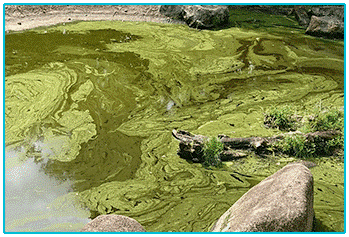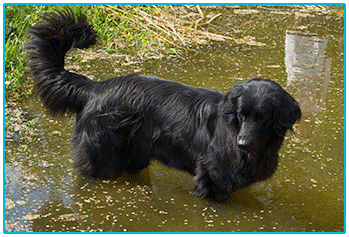For pets, summer is a great time for your pets to get out and about and enjoy the warm weather. However, as is the case during every season, summer has its own set of hazards. One of the things that could be dangerous for your furry friend is blue-green algae. At The Insurance Emporium, we want to keep your pets safe from seasonal risks. That’s why we spoke to our pet health expert about the dangers of blue-green algae.

What is blue-green algae?
Despite the way that blue-green algae looks, it’s actually a type of bacteria, called cyanobacteria. It gathers together to create green and brown floating clumps on water and can make the water look like pea soup. When washed up on the water’s edge it can also look like foam.
Where is it found?
The places you’re most likely to find blue-green algae are lakes, streams, ponds and other places where there is standing water. It can be found at different times of year but more of it is around during the warmer summer months. So, be careful when walking your dog at this time of year.

How will it harm my pet?
Blue-green algae produces various toxins that can cause moderate to severe toxicity in both animals and people. While not all algal blooms are toxic, just small mouthfuls of water that are contaminated with the toxins can be fatal. For this reason, it’s important to keep your pets away from any water where there is blue-green algae.
Symptoms to look out for
The kinds of symptoms your pet might experience from blue-green algae will vary, depending on the toxin that is present. These toxins could cause liver damage or affect the nervous system. Potential effects from them could include salivation, vomiting, diarrhoea, seizures, disorientation, coma, various other neurological signs, difficulty breathing and death.

Precautions
It’s important to keep your pets safe when there’s blue-green algae in bloom. If you spot blue-green algae in any water in your local area, don’t let your dog drink from it or swim in it. Should you suspect that your pet has been exposed to these toxins, make sure you contact your vet immediately.
We all want our pets to live long and happy lives, so the effects of blue-green algae might sound frightening. Yet, with this knowledge, you could be better equipped to deal with it. If you have any concerns that your pet might be in danger of blue-green algae poisoning, be sure to contact your vet.
All content provided on this blog is for informational purposes only. We make no representations as to the accuracy or completeness of any information on this site or found by following any link on this site. We will not be liable for any errors or omissions in this information nor for the availability of this information. We will not be liable for any loss, injury or damage arising from the display or use of this information. This policy is subject to change at any time.


